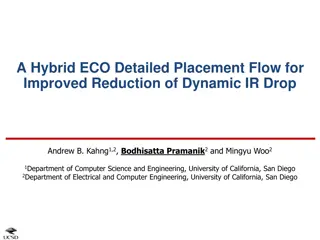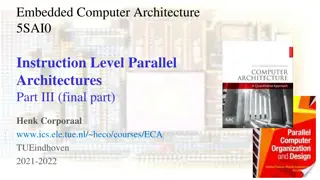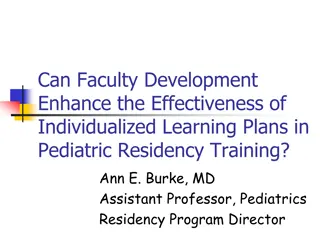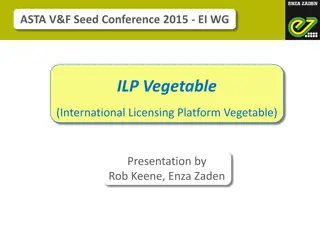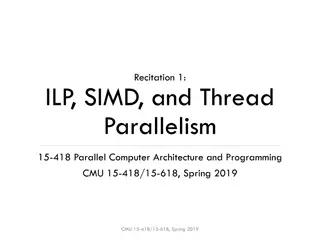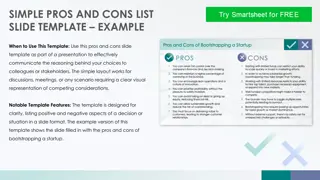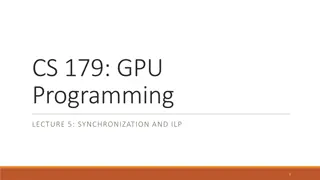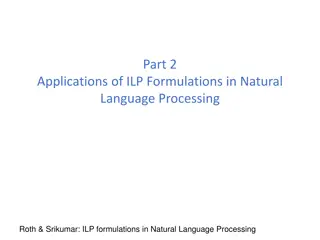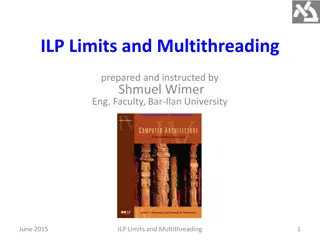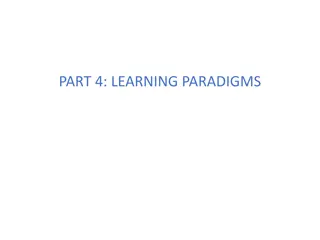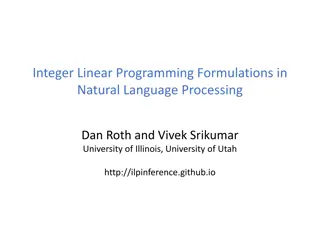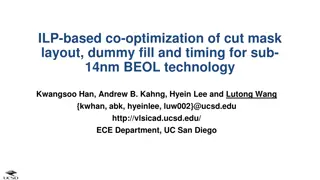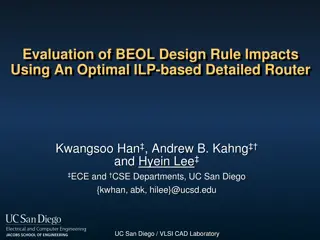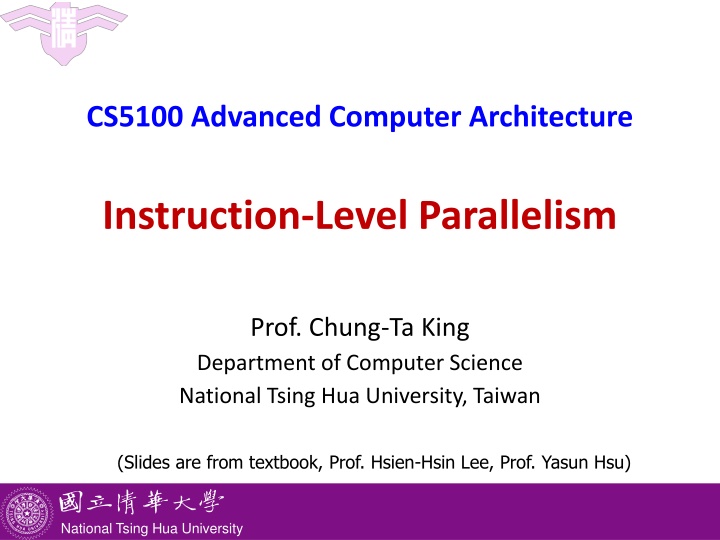
Instruction-Level Parallelism in Advanced Computer Architecture
Explore the basic concepts of instruction-level parallelism and pipelining in advanced computer architecture, along with compiler techniques for harnessing ILP. Delve into the challenges, strategies, and optimizations for exploiting ILP effectively within processors. Learn about sequential program semantics, parallel instructions, and dependencies that impact ILP utilization.
Download Presentation

Please find below an Image/Link to download the presentation.
The content on the website is provided AS IS for your information and personal use only. It may not be sold, licensed, or shared on other websites without obtaining consent from the author. If you encounter any issues during the download, it is possible that the publisher has removed the file from their server.
You are allowed to download the files provided on this website for personal or commercial use, subject to the condition that they are used lawfully. All files are the property of their respective owners.
The content on the website is provided AS IS for your information and personal use only. It may not be sold, licensed, or shared on other websites without obtaining consent from the author.
E N D
Presentation Transcript
CS5100 Advanced Computer Architecture Instruction-Level Parallelism Prof. Chung-Ta King Department of Computer Science National Tsing Hua University, Taiwan (Slides are from textbook, Prof. Hsien-Hsin Lee, Prof. Yasun Hsu) National Tsing Hua University
About This Lecture Goal: To review the basic concepts of instruction-level parallelism and pipelining To study compiler techniques for exposing ILP that are useful for processors with static scheduling Outline: Instruction-level parallelism: concepts and challenges (Sec. 3.1) Basic concepts, factors affecting ILP, strategies for exploiting ILP Basic compiler techniques for exposing ILP (Sec. 3.2) 1 1 National Tsing Hua University
Sequential Program Semantics Human expects sequential semantics A program counter (PC) goes through instructions of the program sequentially until the computation is completed Result of computing is considered correct (ground truth) Any optimizations, e.g. pipelining or parallelism, must keep the same semantics (result) Sequential semantics dictates a computation model of one instruction executed after another While ensuring execution correctness (i.e. sequential semantics), how to optimize executions? Overlapping executions: instruction-level, thread-level, data-level, request-level 2 National Tsing Hua University
Instruction-Level Parallelism (ILP) The parallelism that exists among instructions Example form of parallelism 1: sub r1,r2,r3 add r4,r5,r6 add r4,r5,r6 sub r1,r2,r3 Same result up to here! Example form of parallelism 2: sub r1,r2,r3 add r4,r5,r6 IF DE EX MEM WB Sub-operations can overlap 3 National Tsing Hua University
Instruction-Level Parallelism (ILP) Two instructions are parallel if they can be executed simultaneously in a pipeline of arbitrary depth without causing any stalls, assuming the pipeline has sufficient resources (no structural hazards) If two instructions are dependent, they are not parallel and must be executed in order, although they may be partially overlapped The amount of ILP that can be exploited is affected by program, compiler, and architecture The key is to determine dependences among the instructions Data (true), name, and control dependences 4 National Tsing Hua University
5 National Tsing Hua University
True Dependence Instni followed by Instnj, (but j is not necessary the instruction right next to i), e.g. i writes a value to a register, j uses this value in the register add r2, r4, r6 add r8, r2, r9 i writes to a memory via a write buffer, j loads same value into a register sw r2, 100(r3) lw r4, 100(r3) i loads a register from memory, j uses the content of that register for an operation lw r2, 200(r7) add r1, r2, r3 True dependency reflects sequential semantics and forces sequentiality 6 National Tsing Hua University
True Dependence Causes Data Hazard True dependences indicate data flows and are a result of the program (semantics) True dependence may cause Read-After-Write (RAW) data hazard in pipeline Instni followed by Instnj Instnj tries to read operand before Instni writes it lw r1, 30(r2) W j R i Read old data add r3, r1, r5 W j R i Read new data Want to avoid this 7 National Tsing Hua University
Name Dependence Anti- and output dependences The two instructions use same name (register or memory location) but don t exchange data no data flow Due to bad compiler, architecture limitation Can be solved with renaming (use different registers) lw r2, (r12) true dependence output dependence add r1, r2, 9 anti-dependence mul r2, r3, r4 8 National Tsing Hua University
Anti-Dependence Anti-dependence may cause Write-After-Read (WAR) data hazard Instni followed by Instnj Instnj tries to write to register/memory before Instni reads from that register/memory get wrong, new data W iR j Want to read old value W iR j Get new value instead should avoid this 9 National Tsing Hua University
Output Dependence Output dependence may cause Write-after-Write (WAW) data hazard Instni followed by Instnj Instnj tries to write to register/memory before Instni writes to that register/memory leave wrong result W W i j W W j i should avoid this 10 National Tsing Hua University
Register Renaming Output dependence LW R2 0(R1) LW R2 0(R1) WAW disappears DADD R2 R3 R4 DADD R10 R3 R4 DSUB R6 R2 R5 DSUB R6 R10 R5 Anti-dependence ADD.D F4 F2 F8 ADD.D F4 F2 F8 WAR disappears L.D F2 0(R10) L.D F16 0(R10) SUB.D F14 F2 F6 SUB.D F14 F16 F6 11 National Tsing Hua University
Memory Dependence Ambiguous dependency also forces sequentiality To increase ILP, needs dynamic memory disambiguation mechanisms that are either safe or recoverable i1: lw r2, (r12) ? i2: sw r7, 24(r20) ? ? i3: sw r1, (0xFF00) 12 National Tsing Hua University
Control Dependence Ordering of instruction i with respect to a branch instruction Instruction that is control-dependent on a branch cannot be moved before that branch so that its execution is no longer controlled by the branch An instruction that is not control-dependent on a branch cannot be moved after the branch so that its execution is controlled by the branch bge r8,r9,Next Control dependence add r1,r2,r3 13 National Tsing Hua University
Control Dependence and Basic Blocks Control dependence limits size of basic blocks i1: lw r1, (r11) i2: lw r2, (r12) i3: lw r3, (r13) i4: add r2, r2, r3 i5: bge r2, r9, i9 i6: addi r1, r1, 1 i7: mul r3, r3, 5 i8: j i4 i9: sw r1, (r11) i10: sw r2, (r12) i11: jr r31 a = array[i]; b = array[j]; c = array[k]; d = b + c; while (d<t) { a++; c *= 5; d = b + c; } array[i] = a; array[j] = d; 14 National Tsing Hua University
Control Dependence and Basic Blocks Control dependence limits size of basic blocks i1: lw r1, (r11) i2: lw r2, (r12) i3: lw r3, (r13) i4: add r2, r2, r3 i5: bge r2, r9, i9 i6: addi r1, r1, 1 i7: mul r3, r3, 5 i8: j i4 i9: sw r1, (r11) i10: sw r2, (r12) i11: jr r31 a = array[i]; b = array[j]; c = array[k]; d = b + c; while (d<t) { a++; c *= 5; d = b + c; } array[i] = a; array[j] = d; 15 National Tsing Hua University
Control Flow Graph i1: lw r1, (r11) i2: lw r2, (r12) i3: lw r3, (r13) BB1 BB2 i4: add r2, r2, r3 i5: bge r2, r9, i9 BB3 BB4 i6: addi r1, r1, 1 i7: mul r3, r3, 5 i8: j i4 i9: sw r1, (r11) i10: sw r2, (r12) i11: jr r31 Typical size of basic block = 3~6 instructions 16 National Tsing Hua University
Data Dependence: A Short Summary Dependencies are property of program & compiler Pipeline organization determines if a dependence is detected and if it causes a stall Data dependence conveys: Possibility of a hazard Order in which results must be calculated Upper bound on exploitable ILP Overcome dependences: Maintaining the dependence but avoid a hazard Eliminating dependence by transforming code Dependencies that flow through memory locations are difficult to detect 17 National Tsing Hua University
Another Factor Affecting ILP Exploitation Limited HW/SW window in search of ILP R5 = 8(R6) ILP = 1 R7 = R5 R4 R9 = R7 * R7 ILP = ? R15 = 16(R6) R17 = R15 R14 ILP = 1.5 R19 = R15 * R15 18 National Tsing Hua University
Window in Search of ILP R5 = 8(R6) R15 = 16(R6) C1: R7 = R5 R4 R17 = R15 R14 R19 = R15 * R15 C2: R9 = R7 * R7 C3: ILP = 6/3 = 2 better than 1 + 1.5 Larger window gives more opportunities Who exploit the instruction window? But what limits the window? 19 National Tsing Hua University
Strategies for Exploiting ILP Replicate resources sub r1,r2,r3 add r4,r5,r6 e.g., multiple adders or multi-ported data caches Superscalar architecture Overlap uses of resources Pipelining IF DE EX MEM WB Datapath Reg Reg 20 National Tsing Hua University
Pipelining One machine cycle per stage Synchronous design slowest stage dominates Pure hardware solution; no change to software Ensure sequential semantics All modern machines are pipelined Key technique in advancing performance in the 80 s Data and control signals 21 National Tsing Hua University
Advanced Means of Exploiting ILP Hardware Control speculation (control) Dynamic scheduling (data) Register renaming (data) Dynamic memory disambiguation (data) Software (Sophisticated) program analysis Predication or conditional instruction (control) Better register allocation (data) Memory disambiguation by compiler (data) 22 National Tsing Hua University
Exploiting ILP Any attempt to exploit ILP must make sure the optimized program is still correct Two properties critical to program correctness Data flow: flow of data values among instructions Exception behavior: the ordering of instruction execution must not change how exceptions are raised in program (or, cause any new exceptions), e.g. DADDU R2,R3,R4 BEQZ R2,L LW R1,0(R2) // may cause memory protection L: ... // exception // BEQZ and LW cannot reorder 23 National Tsing Hua University
Exploiting ILP Preserving Data Flow Example 1: L: OR depends on DADDU and DSUBU, but correct execution also depends on BEQZ, not just ordering of DADDU, DSUBU, and OR DADDU R1,R2,R3 BEQZ R4,L DSUBU R1,R1,R6 OR R7,R1,R8 Example 2: skip: OR R7,R8,R9 Assume R4 is not used after skip possible to move DSUBU before the branch without affecting exception or data flow DADDU R1,R2,R3 BEQZ R12,skip DSUBU R4,R5,R6 DADDU R5,R4,R9 24 National Tsing Hua University
Outline Instruction-level parallelism: concepts and challenges (Sec. 3.1) Basic compiler techniques for exposing ILP (Sec. 3.2) 25 25 National Tsing Hua University
Finding ILP gcc has 17% control transfer instructions 5 instructions + 1 branch Must move beyond single block to get more ILP Loop level parallelism gives one opportunity Loop unrolling statically by software or dynamically by hardware Using vector instructions Principle of pipeline scheduling: A dependent instruction must be separated from the source instruction by a distance in clock cycles equal to the pipeline latency of that source instruction How can a compiler perform pipeline scheduling? 26 National Tsing Hua University
Assumptions 5-stage integer pipeline FP ALU: 4-cycles (3 cycle stall for consumer; 2 cycle for ST) LD any: 1 stall FPALU any: 3 stalls FPALU ST: 2 stalls IntALU BR: 1 stall 27 National Tsing Hua University
Compiler Techniques for Exposing ILP Loop: L.D F0,0(R1) for (i=999; i>=0; i=i-1) x[i] = x[i] + s; Add a scalar to a vector Parallel loop stall ADD.D F4,F0,F2 stall stall S.D F4,0(R1) DADDUI R1,R1,#-8 stall BNE R1,R2,Loop // need R1 in ID 9 cycles 28 National Tsing Hua University
Pipeline Scheduling Scheduled code: Loop: L.D DADDUI R1,R1,#-8 ADD.D F4,F0,F2 stall stall S.D BNE F0,0(R1) 7 cycles F4,8(R1) R1,R2,Loop 29 National Tsing Hua University
Loop Unrolling Unroll 4 times (assume # elements is divisible by 4) Eliminate unnecessary instructions Loop: L.D F0,0(R1) ADD.D F4,F0,F2 S.D F4,0(R1) L.D F6,-8(R1) ADD.D F8,F6,F2 S.D F8,-8(R1) L.D F10,-16(R1) ADD.D F12,F10,F2 S.D F12,-16(R1) L.D F14,-24(R1) ADD.D F16,F14,F2 S.D F16,-24(R1) DADDUI R1,R1,#-32 BNE R1,R2,Loop ;drop DADDUI & BNE 27 cycles (LD 1 stall ADDD 2 stall DADDUI 1 stall) ;drop DADDUI & BNE ;drop DADDUI & BNE Note: number of live registers vs. original loop 30 National Tsing Hua University
Loop Unrolling + Pipeline Scheduling Loop: L.D F0,0(R1) F6,-8(R1) F10,-16(R1) F14,-24(R1) ADD.D F4,F0,F2 ADD.D F8,F6,F2 ADD.D F12,F10,F2 ADD.D F16,F14,F2 S.D F4,0(R1) S.D F8,-8(R1) DADDUI R1,R1,#-32 S.D F12,16(R1) S.D F16,8(R1) BNE R1,R2,Loop L.D L.D L.D 14 cycles or 3.5 per iteration OK to move S.D past DADDUI even though changes register OK to move loads before stores: analyze memory address (mem. disambiguate) When is it safe to do such changes? understand dependences 31 National Tsing Hua University
Loop Unrolling: Summary Increase number of instructions relative to the branch and overhead instructions Allow instructions from different iterations to be scheduled together Need to use different registers for each iteration increase register count Usually done early in compilation A pair of consecutive loops are actually generated; the first executes (n mod k) times and the second has the unrolled body that iterates n/k times 32 National Tsing Hua University
Recap What is instruction-level parallelism? Pipelining and superscalar to enable ILP Factors affecting ILP True, anti-, output dependence Dependence may cause pipeline hazard: RAW, WAR, WAW Control dependence, basic block, and control flow graph Compiler techniques for exploiting ILP Loop unrolling 33 National Tsing Hua University



